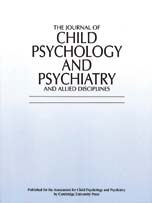No CrossRef data available.
Social Understanding in Autism: Eye Gaze as a Measure of Core Insights
Published online by Cambridge University Press: 23 January 2002
Abstract
Twenty-eight children with autism and 33 MLD children were given two tasks tapping social understanding and a control task tapping probability understanding. For each task there was a measure of eye gaze (where children looked when anticipating the return of a story character or an object) and a verbal measure (a direct question). We found that eye gaze was better than verbal performance at differentiating children with autism from children with MLD. Children with autism did not look to the correct location in anticipation of the story character's return in the social tasks, but they did look to the correct location in the nonsocial probability task. We also found that within the autistic group, children who looked least to the correct location were rated as having the most severe autistic characteristics. Further, we found that whereas verbal performance correlated with general language ability in the autistic group, eye gaze did not. We argue that: (a) eye gaze probably taps unconscious but core insights into social behavior and as such is better than verbal measures at differentiating children with autism from mentally handicapped controls, (b) eye gaze taps either spontaneous processes of simulation or rudimentary pattern recognition, both of which are less based in language, and (c) the social understanding of children with autism is probably based mostly on verbally mediated theories whereas control children also possess more spontaneous insights indexed by eye gaze.
- Type
- Research Article
- Information
- The Journal of Child Psychology and Psychiatry and Allied Disciplines , Volume 42 , Issue 8 , November 2001 , pp. 1083 - 1094
- Copyright
- © 2001 Association for Child Psychology and Psychiatry


